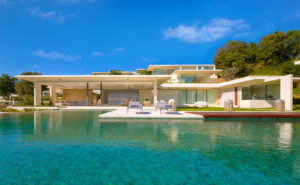How to prevent damage to the walls of your house: Part 1
Many people think that natural stone is only used because of its beauty, they are often unaware that it also provides the building with crucial protection from the elements, reducing maintenance and increasing its lifespan.
The most common problems encountered in a warm humid climate are:
- Wall damage due to the absence of wall capping and proper water drips.
-
Stairs installed without proper over hang and water drips
-
The concrete base of the wall is exposed to the weather due to improper protection.
Wall Capping problem:
No wall capping installed, the wall is untreated raw concrete and the rain runs straight down the side of the building. This building is only three years old and already it is plainly evident that major damage that has started to materialize.
Here we can see a concrete wall that actually has capping. Unfortunately the capping was also made from concrete which is the wrong material to use. Why? Because of its high porosity and susceptibility to damage from heat i.e the Sun. Had there been a water drip present allowing the water to drip on the pavement instead of down the wall it would have slowed the damage down. These mistakes (wrong material choice and no water drip) have resulted in serious permanent damage.
The pebblewash is discolored and impregnated with fungus, while the slate has completely lost its original colors (black and muli-color). The reason for the poor state of the pebble wash is due to the wall missing capping, a common architectural and construction oversight in Thailand.
The slate being natural stone keeps its color for millions of years and is immune to the elements, so why then has it become dull and faded? Originally after installation this part of the wall was lacquered, so that the slate would look darker and more colorful. The other reason people often use lacquer on natural stone is that they mistakenly believe it will seal and protect the stone from elemental damage. What they do not realize is that lacquer becomes damaged by ultraviolet radiation; it loses its luster becoming dull and soapy and starts to peel off. It is possible that this part of the wall can be repaired and reconditioned by stripping off the remaining lacquer and using proper stone restoration chemicals. This is however a time consuming and costly task with no guarantee of success.
This beautiful office building in Muang Thong Thani 3 is three year old and unfortunately while the architect spent an enormous amount of time creating this fantastic looking building they forgot to include any capping with water drips in their design. Fungus & lichen damage is destroying the expensive cladding, which will start falling down within the next few years. If this situation was rectified immediately, only some of the cladding would have to be replace, if nothing is done then all of the cladding will have to come off and be replaced.
If we compare this building to the previous one we can see it has proper capping with water drips protecting the windows. This building was built 16 years ago and has had no maintenance due to being unoccupied. We can see that the windows have no damage unfortunately the capping is made from concrete and is damaged due to sunlight/ rainfall. The solution is to use proper natural stone capping.
This reflection pond at the newly completed Novotel at the Impact Convention Center is already showing signs of damage due to poor design. The containing wall has been clad in granite and the erosion of the joints due to water is clearly visible. The wind is forcing the water over the edge of the wall and it runs down the granite seeping into the joints. If the top of the retaining wall had wider capping with a water drip then the water would drip straight down without hitting the joints.
Stairs:
Proper capping is not only important for wall but also for outdoor stairs, In this photo we see the stairs at Impact Arena, Muang Thong Thani 3 have an insufficient overhang and no water drip causing major damage to concrete.
These stairs are newly installed (5 months) without an overhang and water drip.
Base of Wall:
While it is clear that walls and stairs need to have capping to protect them from falling water damage and erosion of the joints, did you know that the base of a wall also needs protection? Why? When water hits the ground it splashes up and if the base of your wall is not protected, the water will start to damage it there. In this photo we can see the absence of proper protection and the base of the wall is covered in fungus that is destroying the cement.
This is a different building that is also showing damage from water that has splashed up and started to destroy the base. The solution is simple, use proper natural stone to clad the base.
When we say proper natural stone we mean a stone that is able to withstand the assault of the elements.
โดยส่วนมากแล้ว ลูกค้าหลายท่านจะเข้าใจว่า การใช้หินธรรมชาติในการตกแต่งบ้านเรือนอาคารเป็นเพียงเพื่อความสวยงามเท่านั้น แต่โดยแท้จริงแล้วการใช้หินธรรมชาติไม่เพียงแต่เพื่อสร้างความสวยงามเพียงอย่างเดียว แต่ยังช่วยป้องกันความเสียหายของอาคารที่เกิดจากสภาพอากาศ ทั้งแสงแดด และพายุฝน และยังช่วยลดค่าใช้จ่ายในการบำรุงรักษาอาคารเหล่านั้นด้วย
ปัญหาที่พบบ่อยที่สุดในสภาพภูมิอากาศร้อนชื้นแบบประเทศไทย คือ
- ความเสียหายของผนังด้านนอกอาคาร เนื่องจากไม่ได้ติดตั้งขอบผนัง และร่องน้ำไหล เพื่อหลีกเลี่ยงคราบสกปรกไหลลงติดผนังอาคาร
- บันได ติดตั้งไม่ถูกต้อง เนื่องจากขาดขอบบันได และร่องน้ำไหล
- ตัวฐานอาคารคอนกรีต ขาดขอบผนังเพื่อป้องกันคราบสกปรกที่เกิดจากการกระเด็นจากพื้นดิน
ปัญหาคราบสกปรกของผนังด้านนอก:
อาคารคอนกรีตไม่ได้ติดตั้งขอบด้านบนและเซาะร่องน้ำไหลเพื่อระบายทางเดินของน้ำ เป็นสาเหตุทำให้เกิดคราบสกปรกจากพายุฝนไหลลงเป็นทางยาวของอาคาร และคราบสกปรกก็ยังฝังแน่นติดบนผนังอาคารขาดความสวยงาม ซึ่งจากภาพถ่ายอาคารแห่งนี้เห็นได้ชัดเจนของปัญหาดังกล่าว เนื่องจากอาคารนี้ถูกสร้างมาประมาณแค่ 3 ปีเท่านั้น แต่กลับได้รับความเสียหายดูเหมือนอาคารเก่าๆหลังหนึ่ง
จากภาพถ่ายนี้อาคารได้ติดตั้งขอบผนังเพื่อป้องกันคราบสกปรก แต่น่าเสียดายที่ขอบผนังดังกล่าวสร้างจากคอนกรีตซึ่งเป็นวัสดุที่ไม่เหมาะสมกับการใช้งาน และเนื่องจากความแข็งแรงของวัสดุไม่สามารถต้านทานความร้อนสูงจากแสงแดดและเมื่อกระทบกับความชื้นสลับกับความร้อนตลอดเวลา ทำให้คอนกรีตเกิดรอยแตกเสียหาย อีกทั้งขอบผนังดังกล่าวยังไม่มีร่องน้ำไหลเพื่อป้องกันการไหลของน้ำ จึงเป็นสาเหตุทำให้เกิดคราบสกปรกไหลเป็นทางบนผนังอยู่เช่นเดิม ทั้งนี้สาเหตุหลักของปัญหานี้ คือ เลือกวัสดุผิดประเภทกับการใช้งาน และไม่ได้ทำร่องน้ำไหลเพื่อป้องกันการเดินทางของน้ำ
การติดตั้งหินกรวดล้างที่พบเห็นบ่อยครั้งในบ้านเรา มักจะเกิดคราบเชื้อราและตะไคร้น้ำบนผนัง ซึ่งสาเหตุหลักของปัญหา คือ สัดส่วนของสีและคอนกรีตมีมากกว่าสัดส่วนของหินกรวด ส่งผลให้ผนังเกิดเชื้อราและตะไคร้น้ำได้ง่าย อีกทั้งยังไม่ได้ติดตั้งขอบผนังเพื่อหลีกเลี่ยงการปะทะโดยตรงของพายุฝนและคราบสกปรกต่างๆ
และทั้งนี้โดยธรรมชาติของหินกาบหรือหินชนวน สีของมันจะอยู่ได้นานเป็นล้านๆปี แต่ทำไมจากภาพถ่ายสีของหินกาบกลับมีสีที่ซืดจางหม่นหมอง ทั้งนี้เป็นผลมาจาการใช้เลคเกอร์ทาบนหน้าหิน เพื่อทำให้สีหินเข้มมากขึ้น และด้วยความเชื่อแบบผิดๆว่า การทาเลคเกอร์จะช่วยกันซึมหน้าหินและช่วยลดความเสียหายของหน้าหินจากแสงแดดได้ แต่ท่านลืมนึกไปว่าเลคเกอร์จะถูกทำลายโดยแสงแดดและหลุดลอกออกไปในช่วงเวลาอันสั้นไม่เหลือความเงางามของหินไว้ ทั้งยังทิ้งคราบเหนียวสกปรกบนหินอีกด้วย
อาคารสำนักงานที่สวยงามแห่งนี้ เป็นที่น่าเสียดายที่สถาปนิกผู้ออกแบบได้ใช้เวลาอันยาวนานเพื่อคิดค้นออกแบบอาคาร เพื่อสร้างผลงานให้ออกมาอย่างดีที่สุด แต่พวกเขาลืมตะหนักถึงการใช้งานจริง เพื่อให้เข้ากับสภาพอากาศของบ้านเรา นั่นคือ การออกแบบขอบผนังรวมไปถึงร่องน้ำไหล เพื่อป้องกันคราบสกปรกของผนังด้านนอกอาคารเมื่อเกิดลมพายุฝน ซึ่งปัจจัยดังกล่าวอาจก่อให้เกิดตะไคร้น้ำและเชื้อราบนผนังและสร้างความเสียหายให้กับอาคารในอีกไม่กี่ปีข้างหน้า
เมื่อเราเปรียบเทียบอาคารในภาพนี้กับอาคารก่อนหน้านี้ ท่านจะสามารถเห็นได้ชัดถึงความแตกต่างของผนังอาคารทั้ง 2 หลัง เนื่องจากอาคารหลังนี้ได้ถูกออกแบบ สร้างขอบผนังและร่องน้ำไหลเพื่อป้องกันมิให้คราบสกปรกจากพายุฝนกระทบโดยตรงกับผนังอาคาร อาคารหลังนี้ถูกสร้างมากว่า 16 ปีแล้ว แต่ยังคงความสวยงามอยู่เช่นเดิม แต่เป็นที่น่าเสียดายที่ขอบผนังสร้างจากปูนคอนกรีต ซึ่งวัสดุดังกล่าวไม่สามารถทนต่อความร้อนสูงและพายุฝนได้ ทำให้สภาพปูนเริ่มทรุดโทรมแตกเสียหาย ทางแก้ปัญหานี้ คือ ควรใช้หินธรรมชาติซึ่งมีความแข็งแรง ทนทานต่อทุกสภาพอากาศ
ภาพนี้คือ สระน้ำหน้าโรงแรมโนโวเทล-อิมเพคเมืองทองธานีที่เพิ่งถูกสร้างเสร็จเมื่อไม่นานมานี้ และจากภาพถ่ายเห็นได้ชัดถึงคราบสกปรกบนแผ่นหินแกรนิต อันเนื่องมาจากการออกแบบขอบสระที่ไม่ถูกต้อง ซึ่งแท้จริงแล้วควรออกแบบขอบสระด้านบนให้มีขนาดกว้างกว่าขอบปูน และทำร่องน้ำไหล เพื่อป้องกันมิให้น้ำไหลลงบนแผ่นหินแกรนิตโดยตรงและไหลไปตามร่องหินซึ่งก่อให้เกิดคราบปูนในที่สุด ทั้งนี้ถ้าหากขอบสระกว้างกว่าขอบปูนแล้วน้ำก็จะไหลลงสู่พื้นทันที แต่ทั้งนี้ไม่ควรลืมทำร่องน้ำไหลด้วย มิฉะนั้นปัญหาก็ยังคงเป็นอยู่เช่นเดิม
การเซาะร่องน้ำไหลไม่เพียงแต่มีความสำคัญต่อผนังอาคารเท่านั้น แต่ยังรวมไปถึงบันไดนอกอาคารด้วยซึ่งจากภาพถ่ายนี้จะสามารถเห็นได้อย่างชัดเจนของคราบสกปรกจากลูกตั้งบันไดซึ่งเกิดจากคราบพายุฝน เนื่องจากลูกนอนไม่ได้เซาะร่องน้ำไหลไว้ทำให้คอนกรีตลูกตั้งเกิดความเสียหายดังจะเห็นได้จากภาพถ่าย
ภาพบันไดนี้ ได้ถูกติดตั้งมาแล้วประมาณ5เดือนที่แล้ว แต่สภาพบันไดดูเก่าทรุดโทรมและเต็มไปด้วยคราบสกปรก อันเนื่องมาจากลูกนอนมีความกว้างน้อยเกินไป อีกทั้งยังไม่ได้เซาะร่องน้ำไหลจึงเกิดคราบสกปรกได้ง่าย
ท่านได้ทราบเหตุผลแล้วว่าทำไมผนังและบันไดนอกอาคารจึงต้องการขอบป้องกันและร่องน้ำไหล แต่ท่านทราบด้วยหรือไม่ว่า ขอบพื้นผนังอาคารก็ยังต้องการการป้องกันเช่นเดียวกัน ทำไมหรือ? เพราะ
เมื่อฝนตกกระทบลงพื้นดินหรือพื้นคอนกรีตจะกระเด็นไปถูกผนังอาคารทำให้คราบสกปรกติดบนผนังและเมื่อคราบสกปรกดังกล่าวถูกทิ้งไว้เป็นระยะเวลาอันยาวนานก็จะสะสมคราบตะไคร้ เชื้อราต่างๆ ส่งผลให้โครงสร้างอาคารเสียหายได้ จากภาพถ่ายจะเห็นได้ว่าขอบพื้นผนังอาคารไม่ได้ติดตั้งขอบผนังเพื่อป้องกันคราบน้ำและคราบสกปรกจากพื้น ทำให้ผนังคอนกรีตถูกทำลายด้วยคราบตะไคร้และเชื้อรา
ภาพนี้ก็เช่นเดียวกันได้แสดงให้เห็นถึงความเสียหายของพื้นผนังอาคารที่ได้รับความเสียหายจากการกระเด็นของน้ำและการเซาะกร่อนของซีเมนต์ ซึ่งวิธีแก้ปัญหานี้ง่ายมาก คือ ติดตั้งหินธรรมชาติกับพื้นผนังอาคารแนวตั้งเพื่อป้องกันการเซาะกร่อนของอาคารจากน้ำ และเมื่อกล่าวถึงหินธรรมชาติแล้ว นั่นหมายถึงหินที่สามารถทนต่อสภาพอากาศภายนอกได้เป็นอย่างดี



You must be logged in to post a comment.